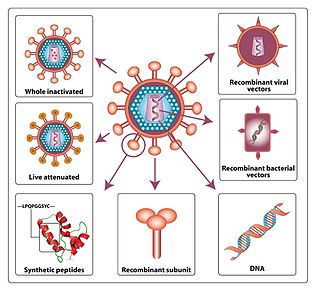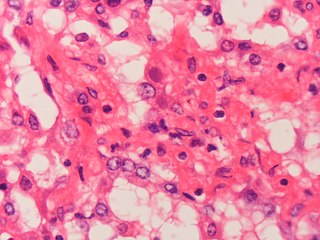
An HIV vaccine is a potential vaccine that could be either a preventive vaccine or a therapeutic vaccine, which means it would either protect individuals from being infected with HIV or treat HIV-infected individuals.

Pogona is a genus of reptiles containing eight lizard species, which are often known by the common name bearded dragons. The name "bearded dragon" refers to the underside of the throat of the lizard, which can turn black and become inflated for a number of reasons, most often as a result of stress, if they feel threatened, or are trying to entice a mate. They are a semiarboreal species, spending significant amounts of time on branches, in bushes, and near human habitation. Pogona species bask on rocks and exposed branches in the mornings and afternoons and sleep at night, making them a diurnal species. Their diet consists primarily of vegetation and some insects. They are found throughout much of Australia and inhabit environments such as deserts, and shrublands.

The central bearded dragon, also known as the inland bearded dragon, is a species of agamid lizard found in a wide range of arid to semiarid regions of eastern and central Australia.

Adenoviruses are medium-sized, nonenveloped viruses with an icosahedral nucleocapsid containing a double-stranded DNA genome. Their name derives from their initial isolation from human adenoids in 1953.

Infectious bursal disease (IBD), also known as Gumboro disease, infectious bursitis, and infectious avian nephrosis, is a highly contagious disease of young chickens and turkeys caused by infectious bursal disease virus (IBDV), characterized by immunosuppression and mortality generally at 3 to 6 weeks of age. The disease was first discovered in Gumboro, Delaware in 1962. It is economically important to the poultry industry worldwide due to increased susceptibility to other diseases and negative interference with effective vaccination. In recent years, very virulent strains of IBDV (vvIBDV), causing severe mortality in chicken, have emerged in Europe, Latin America, South-East Asia, Africa, and the Middle East. Infection is via the oro-fecal route, with affected birds excreting high levels of the virus for approximately 2 weeks after infection. The disease is easily spread from infected chickens to healthy chickens through food, water, and physical contact.
Aviadenoviruses are adenoviruses that affect birds—particularly chickens, ducks, geese, turkeys and pheasants. There are 15 species in this genus. Viruses in this genus cause specific disease syndromes such as Quail Bronchitis (QB), Egg Drop Syndrome (EDS), Haemorrhagic Enteritis (HE), Pheasant Marble Spleen Disease (MSD), and Inclusion Body Hepatitis (IBH). Avian adenoviruses have a worldwide distribution and it is common to find multiple species on a single farm. The most common serogroups are serogroup 1, 2 and 3.

The eastern bearded dragon, also known as common bearded dragon or simply bearded lizard, is an agamid lizard found in wooded parts of Australia. It is one of a group of species known commonly as bearded dragons. Other common names for this species include Jew lizard and frilly lizard, the latter being a confusion between this and another dragon, the frill-necked lizard. This species was originally described in 1829 by Georges Cuvier, who named it Amphibolurus barbatus.
Viral pneumonia is a pneumonia caused by a virus. Pneumonia is an infection that causes inflammation in one or both of the lungs. The pulmonary alveoli fill with fluid or pus making it difficult to breathe. Pneumonia can be caused by bacteria, viruses, fungi or parasites. Viruses are the most common cause of pneumonia in children, while in adults bacteria are a more common cause.
Enterocolitis is an inflammation of the digestive tract, involving enteritis of the small intestine and colitis of the colon. It may be caused by various infections, with bacteria, viruses, fungi, parasites, or other causes. Common clinical manifestations of enterocolitis are frequent diarrheal defecations, with or without nausea, vomiting, abdominal pain, fever, chills, and alteration of general condition. General manifestations are given by the dissemination of the infectious agent or its toxins throughout the body, or – most frequently – by significant losses of water and minerals, the consequence of diarrhea and vomiting.

Adenovirus infection is a contagious viral disease, caused by adenoviruses, commonly resulting in a respiratory tract infection. Typical symptoms range from those of a common cold, such as nasal congestion, coryza and cough, to difficulty breathing as in pneumonia. Other general symptoms include fever, fatigue, muscle aches, headache, abdominal pain and swollen neck glands. Onset is usually two to fourteen days after exposure to the virus. A mild eye infection may occur on its own, combined with a sore throat and fever, or as a more severe adenoviral keratoconjunctivitis with a painful red eye, intolerance to light and discharge. Very young children may just have an earache. Adenovirus infection can present as a gastroenteritis with vomiting, diarrhoea and abdominal pain, with or without respiratory symptoms. However, some people have no symptoms.

Meningoencephalitis, also known as herpes meningoencephalitis, is a medical condition that simultaneously resembles both meningitis, which is an infection or inflammation of the meninges, and encephalitis, which is an infection or inflammation of the brain tissue.
Equid alphaherpesvirus 1, formerly Equine herpesvirus 1 (EHV-1), is a virus of the family Herpesviridae that causes abortion, respiratory disease and occasionally neonatal mortality in horses. Initial spread of EHV-1 by a newly introduced horse through direct and indirect contact can lead to abortion and perinatal infection in up to 70 percent of a previously unexposed herd. Abortion usually occurs in the last four months of gestation, two to four weeks after infection of the mare. Perinatal infection can lead to pneumonia and death. Encephalitis can occur in affected animals, leading to ataxia, paralysis, and death. There is a vaccine available, however its efficacy is questionable. The virus varies in severity from sub-clinical to very severe. Most horses have been infected with EHV-1, but the virus can become latent and persist without ever causing signs of infection. In 2006, an outbreak of EHV-1 among stables in Florida resulted in the institution of quarantine measures. The outbreak was determined to have originated in horses imported from Europe via New York, before being shipped to Florida.

Sapovirus is a genetically diverse genus of single-stranded positive-sense RNA, non-enveloped viruses within the family Caliciviridae. Together with norovirus, sapoviruses are the most common cause of acute gastroenteritis in humans and animals. It is a monotypic taxon containing only one species, the Sapporo virus.

Rankin's dragon is a species of Australian agamid lizard. It may also be called the pygmy bearded dragon and the black-soiled bearded dragon.
Animal viruses are viruses that infect animals. Viruses infect all cellular life and although viruses infect every animal, plant, fungus and protist species, each has its own specific range of viruses that often infect only that species.
Toscana phlebovirus (TOSV) is an arbovirus belonging to Bunyavirales, an order of negative-stranded, enveloped RNA viruses. The virus can be transmitted to humans by the bite of an infected sandfly of the genus Phlebotomus. Toscana is not normally associated with disease, as indicated by high seroprevalence rates in endemic areas, but in common with other sandfly transmitted viruses such as Naples virus and Sicilian virus, infection may result in Pappataci fever, an illness with mild fever, headache and myalgia. In serious cases that go undiagnosed, acute meningitis, meningoencephalitis and encephalitis may occur. There is no specific treatment for infection, so treatment is supportive, reducing the severity of symptoms until the immune system has cleared the infection.
Adenovirus varieties have been explored extensively as a viral vector for gene therapy and also as an oncolytic virus.
Falcon aviadenovirus A is an avian adenovirus that infects birds of the genus Falco, commonly called falcons. The virus was first discovered in 1996 in an epizootic of inclusion body hepatitis and enteritis in aplomado and peregrine falcons. It can also infect orange-breasted falcons, taitas, merlins, and American kestrels.

Egg drop syndrome '76 is a viral disease that affects birds, notably chickens, ducks, geese and swans. It is characterised by a sudden drop in production of eggs as well as its eggshell quality in apparent healthy laying birds.

Adenoviral keratoconjunctivitis, also known as epidemic keratoconjunctivitis, is a contagious eye infection, a type of adenovirus disease caused by adenoviruses. It typically presents as a conjunctivitis with a sudden onset of a painful red eye, watery discharge and feeling that something is in the eye. Photophobia develops with blurred vision and lymphadenopathy by the ear nearest the affected eye. It is often associated with a sore throat and stuffy and runny nose, mainly in adults. A type of adenoviral keratoconjunctivitis in very young children can present with a high fever, sore throat, ear infection, vomiting and diarrhea.












